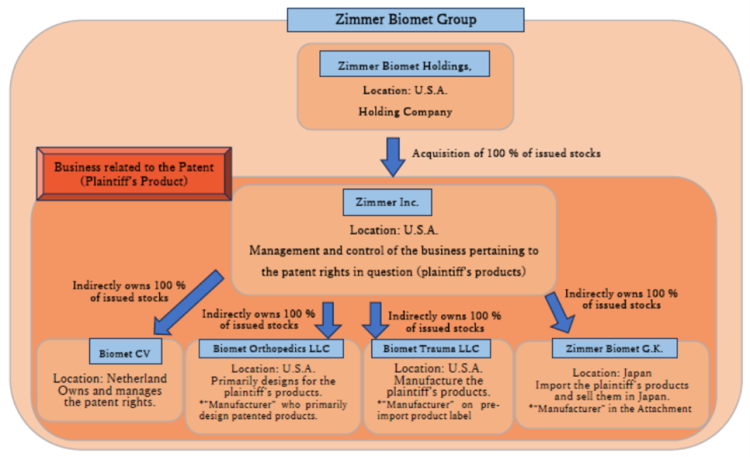1. Summary of the Judgment
In the Judgment, with regard to the scope of application of Article 102, Paragraph 2, of the Patent Act, based on the established decisional framework in preceding cases that the provision is applicable “where circumstances exist in which the patentee could have obtained profits had there been no infringement of the patent by the infringer,” the court approved the application of Article 102, Paragraph 2 of the Patent Act, because it was alleged and proved in the High Court that the patentee and the implementer of the patented invention were all wholly owned subsidiaries of the ultimate parent company, and that they managed and exercised the patent rights under the control and direction of the ultimate parent company, and manufactured the plaintiff’s products using the patent rights.

2. Related Court Case: Intellectual Property Court Case No. 10015 (Ne) 2012 [Waste Storage Device, Grand Panel Case of IP High Court]
The decision in the Grand Panel case of Waste Storage Device broadly recognized the application of Article 102, Paragraph 2, of the Patent Act even if the patentee themselves is not implementing the patented invention, holding as follows (underlining added by the author):
“The plaintiff entered into an Agency Agreement with Combi, pursuant to which Combi is the distributor of the plaintiff’s products in Japan, and the plaintiff sells (exports) cassettes, which are related to invention 1 manufactured in the U.K. by the plaintiff, to Combi.
In this case, the facts that follow are held. Combi sells the above-mentioned cassettes manufactured by the plaintiff to general consumers in Japan. Based on the foregoing, it can be said that the plaintiff sells cassettes manufactured by the plaintiff in Japan through Combi. By importing and selling Article 1 in Japan, the defendant is in a competitive relationship with Combi but also with the plaintiff in the Japanese market for waste storage cassettes. Sales of the plaintiff’s cassettes in Japan have been decreasing due to the defendant’s infringing acts. In light of the above factual background, there are circumstances in which the plaintiff could have obtained profits had it not been for the defendant’s infringement. Therefore, there is no reason why the application of Article 102, Paragraph 2, of the Patent Act should be excluded in calculating the amount of plaintiff’s damages.”
Writer: Hideki TAKAISHI
Supervising editor: Kazuhiko YOSHIDA
Hideki TAKAISHI
Attorney at Law & Patent Attorney
Nakamura & Partners
Room No. 616, Shin-Tokyo Building,
3-3-1 Marunouchi, Chiyoda-ku,
Tokyo 100-8355, JAPAN